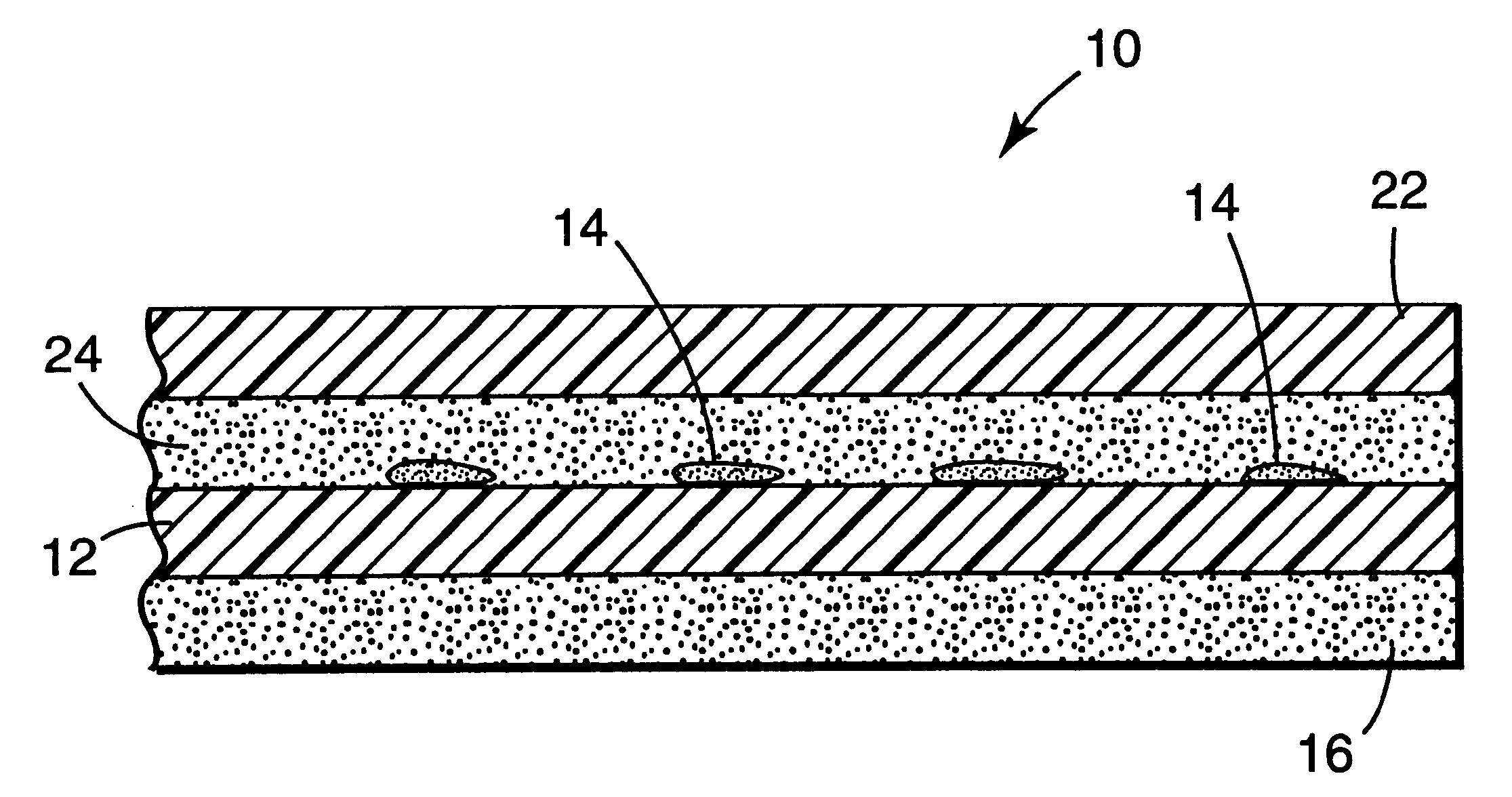Method of stabilizing films or membranes using adhesive as a reservoir
a technology of stabilizing film or membrane and adhesive, which is applied in the direction of film/foil adhesive, instruments, other domestic articles, etc., can solve the problems of limited amount of stabilizing agent, image fading or other weathering effects, and environmental exposure, so as to reduce or slow the effect of light energy, facilitate the migration of such agents, and minimize the effect of perceptible color chang
- Summary
- Abstract
- Description
- Claims
- Application Information
AI Technical Summary
Benefits of technology
Problems solved by technology
Method used
Image
Examples
example 1
A polypropylene microporous membrane prepared using thermally induced phase separation techniques according the disclosures of U.S. Pat. No. 4,539,256 (Shipman et al.), U.S. Pat. No. 4,726,989 (Mrozinski), and more particularly U.S. Pat. No. 5,120,594 (Mrozinski), the disclosures of which are incorporated herein by reference, and had the following characteristics:
Thickness--0.091 mm (3.6 mil)
Porosity--41.9%
Bubble Point--0.52 .mu.m
Gurley--24 s / 50 cm.sup.3
5 pieces, of 2.54 cm by 5.08 cm, were cut from the membrane and attached to an aluminum plate in the following way:
Control Sample 1A--with 0.02 mm (1 mil) 3M Clear Application Adhesive 8560 (3M Commercial Graphics Division, St. Paul, Minn., USA)
Sample 1B--with 0.02 mm (1 mil) 2-methylbutylacylate / acrylic acid (90:10)
pressure sensitive adhesive ("Test Adhesive")
Sample 1C--with 0.05 mm (2 mil) Test Adhesive
Sample 1D--with 0.07 mm (3 mil) Test Adhesive
Sample 1E--with 0.10 mm (4 mil) Test Adhesive
The adhesive of Control Sample 1A had no ...
example 2
Another polypropylene membrane was prepared in the same manner as in Example 1 and had the following characteristics:
Thickness--0.167 mm (6.6 mil)
Porosity--42.0%
Bubble Point--0.58 .mu.m
Gurley--16.2 s / 50 cm.sup.3
5 pieces, of 2.54 cm by 5.08 cm (1 by 2 inches), were cut from the membrane having adhesives matching Control Sample A and Samples B-F and attached to aluminum plate in the following way:
Control Sample 2A--with 0.02 mm (1 mil) 3M Adhesive 8560
Sample 2B--with 0.02 mm (1 mil) Test Adhesive
Sample 2C--with 0.05 mm (2 mil) Test Adhesive
Sample 2D--with 0.07 mm (3 mil) Test Adhesive
Sample 2E--with 0.10 mm (4 mil) Test Adhesive
The adhesive of Control Sample 2A had no UV stabilizers. The adhesive of Samples 2B-2E had 2.0% of Tinuvin 1130 UVA, 3.5% of Tinuvin 123 HALS and 0.4% of Irganox 1010 Antioxidant.
The aluminum plate with attached samples was then subjected to the same accelerated testing as in Example 1 Control Sample 2A developed several cracks before reaching 200 hours mark; S...
example 3
A polypropylene membrane was prepared as in Example 1 and had the following characteristics:
Thickness--0.12 mm (4.9 mil)
Porosity--85.6%
Bubble Point--1.0 .mu.m
Gurley--4.3 s / 50 cm.sup.3
2 pieces, of 2.54 cm by 5.08 cm, were cut from the membrane and attached to aluminum plate in the following way:
Control Sample 3A--with 0.02 mm (1 mil) 3M Adhesive 8560
Sample 3B--with 0.02 mm (1 mil) 3M Test Adhesive
The adhesive of Control Sample 3A had no UV stabilizers. The adhesive of Sample 3B had 2.0% of Tinuvin 1130 UVA, 3.5% of Tinuvin 123 HALS and 0.4% of Irganox 1010 Antioxidant.
The aluminum plate with attached samples was then subjected to the same accelerated testing as in Example 1, except for up to 500 hours. Control Sample 3A developed several cracks and its surface was chalking off before reaching the 200 hours mark; Sample 3B after 500 hours did not show any cracks and its surface was not chalking off. This Example shows that yet another polymeric membrane can be protected by the method ...
PUM
| Property | Measurement | Unit |
|---|---|---|
| light energy | aaaaa | aaaaa |
| adhesive | aaaaa | aaaaa |
| total weight | aaaaa | aaaaa |
Abstract
Description
Claims
Application Information
 Login to View More
Login to View More - R&D
- Intellectual Property
- Life Sciences
- Materials
- Tech Scout
- Unparalleled Data Quality
- Higher Quality Content
- 60% Fewer Hallucinations
Browse by: Latest US Patents, China's latest patents, Technical Efficacy Thesaurus, Application Domain, Technology Topic, Popular Technical Reports.
© 2025 PatSnap. All rights reserved.Legal|Privacy policy|Modern Slavery Act Transparency Statement|Sitemap|About US| Contact US: help@patsnap.com


